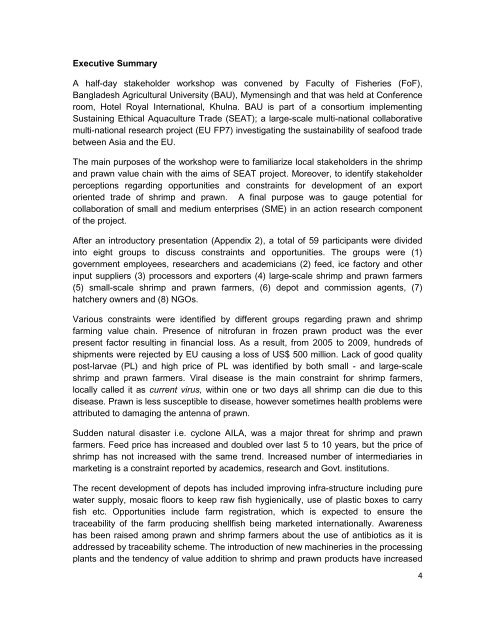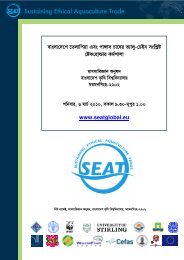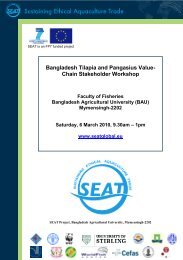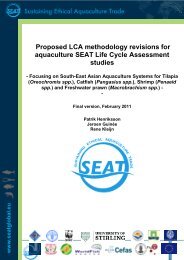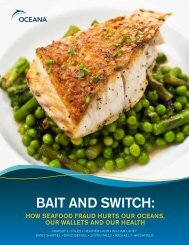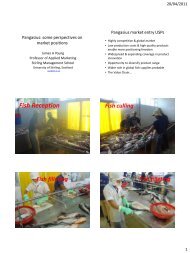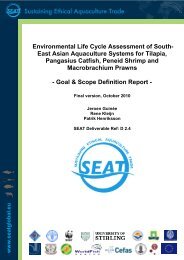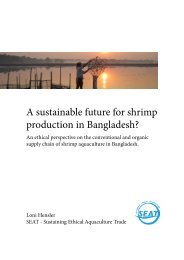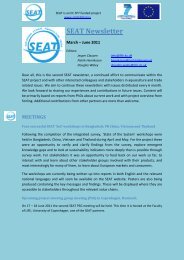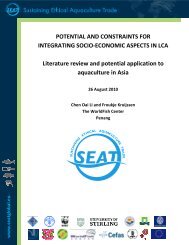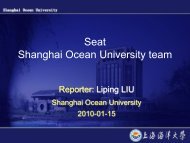English - SEAT is....
English - SEAT is....
English - SEAT is....
You also want an ePaper? Increase the reach of your titles
YUMPU automatically turns print PDFs into web optimized ePapers that Google loves.
Executive Summary<br />
A half-day stakeholder workshop was convened by Faculty of F<strong>is</strong>heries (FoF),<br />
Bangladesh Agricultural University (BAU), Mymensingh and that was held at Conference<br />
room, Hotel Royal International, Khulna. BAU <strong>is</strong> part of a consortium implementing<br />
Sustaining Ethical Aquaculture Trade (<strong>SEAT</strong>); a large-scale multi-national collaborative<br />
multi-national research project (EU FP7) investigating the sustainability of seafood trade<br />
between Asia and the EU.<br />
The main purposes of the workshop were to familiarize local stakeholders in the shrimp<br />
and prawn value chain with the aims of <strong>SEAT</strong> project. Moreover, to identify stakeholder<br />
perceptions regarding opportunities and constraints for development of an export<br />
oriented trade of shrimp and prawn. A final purpose was to gauge potential for<br />
collaboration of small and medium enterpr<strong>is</strong>es (SME) in an action research component<br />
of the project.<br />
After an introductory presentation (Appendix 2), a total of 59 participants were divided<br />
into eight groups to d<strong>is</strong>cuss constraints and opportunities. The groups were (1)<br />
government employees, researchers and academicians (2) feed, ice factory and other<br />
input suppliers (3) processors and exporters (4) large-scale shrimp and prawn farmers<br />
(5) small-scale shrimp and prawn farmers, (6) depot and comm<strong>is</strong>sion agents, (7)<br />
hatchery owners and (8) NGOs.<br />
Various constraints were identified by different groups regarding prawn and shrimp<br />
farming value chain. Presence of nitrofuran in frozen prawn product was the ever<br />
present factor resulting in financial loss. As a result, from 2005 to 2009, hundreds of<br />
shipments were rejected by EU causing a loss of US$ 500 million. Lack of good quality<br />
post-larvae (PL) and high price of PL was identified by both small - and large-scale<br />
shrimp and prawn farmers. Viral d<strong>is</strong>ease <strong>is</strong> the main constraint for shrimp farmers,<br />
locally called it as current virus, within one or two days all shrimp can die due to th<strong>is</strong><br />
d<strong>is</strong>ease. Prawn <strong>is</strong> less susceptible to d<strong>is</strong>ease, however sometimes health problems were<br />
attributed to damaging the antenna of prawn.<br />
Sudden natural d<strong>is</strong>aster i.e. cyclone AILA, was a major threat for shrimp and prawn<br />
farmers. Feed price has increased and doubled over last 5 to 10 years, but the price of<br />
shrimp has not increased with the same trend. Increased number of intermediaries in<br />
marketing <strong>is</strong> a constraint reported by academics, research and Govt. institutions.<br />
The recent development of depots has included improving infra-structure including pure<br />
water supply, mosaic floors to keep raw f<strong>is</strong>h hygienically, use of plastic boxes to carry<br />
f<strong>is</strong>h etc. Opportunities include farm reg<strong>is</strong>tration, which <strong>is</strong> expected to ensure the<br />
traceability of the farm producing shellf<strong>is</strong>h being marketed internationally. Awareness<br />
has been ra<strong>is</strong>ed among prawn and shrimp farmers about the use of antibiotics as it <strong>is</strong><br />
addressed by traceability scheme. The introduction of new machineries in the processing<br />
plants and the tendency of value addition to shrimp and prawn products have increased<br />
4


